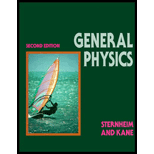
(a)
The fractional transmitted energy.
(a)
Answer to Problem 69E
The fractional transmitted energy is
Explanation of Solution
Write the expression for conservation of momentum.
Here,
Substitute
Write the expression for conservation of Kinetic energy.
Substitute
Substitute
Rearrange the above expression in terms of
Here,
Substitute
Simplify the above expression.
Rearrange the above expression in terms of
Square both sides of above expression.
Substitute
Simplify the above expression.
Conclusion:
Thus, the fractional transmitted energy is
(b)
The fractional reflected energy.
(b)
Answer to Problem 69E
The fractional reflected energy is
Explanation of Solution
Write the expression for fractional reflected energy.
Substitute
Here,
Conclusion:
Thus, the fractional reflected energy is
(c)
The fraction of energy transmitted and reflected.
(c)
Answer to Problem 69E
The fractional transmitted energy is
Explanation of Solution
Conclusion:
For
Substitute
Substitute
For
Substitute
Substitute
For
Substitute
Substitute
Thus, the fractional transmitted energy is
Want to see more full solutions like this?
Chapter 22 Solutions
General Physics, 2nd Edition
- In an elastic collision of two particles with masses m1 and m2, the initial velocities are u1 and u2 = u1. If the initial kinetic energies of the two particles are equal, find the conditions on u1/u2 and m1/m2 such that m1 is at rest after the collision. Examine both cases for the sign of .arrow_forwardA particle of mass m moving along the x-axis with a velocity component +u collides head-on and sticks to a particle of mass m/3 moving along the x-axis with the velocity component −u. What is the mass M of the resulting particle?arrow_forwardan object of mass m and velocity v collides elastically with a stationary object and continuies in the same direction with a speed of 0.25v. what is the mass of the object that was initially stationaryarrow_forward
- Show solution A particle A, of mass 8 kg, collides with a particle B, of mass m2 kg. The velocity of particle A before the collision was 5 m/s and the velocity of particle B before the collision was 2.2 m/s. Given the velocity of particle A after the collision was -4 m/s, and the velocity of particle B was 3 m/s, what was the mass of particle B?arrow_forwardTwo solid iron spheres of masses m and 2m respectively, are suspended from two inextensible ropes of length l. We separate the ball of mass m from its equilibrium position at an angle α, keeping the string extended in the same plane. The mass is released and collides elastically with the sphere of mass 2m. The speed of the sphere sphere of mass m immediately after the collision is:arrow_forwardA golf ball of mass m = 0.18 kg is dropped from a height h. It interacts with the floor for t = 0.11 s, and applies a force of F = 17.5 N to the floor when it elastically collides with it. Randomized Variablesm = 0.18 kgt = 0.11 sF= 17.5 N Write an expression for the ball's velocity, v, in terms of the variables m, t, and F, just after it rebounds from the floor. (Hint: The fact that the collision is elastic is important when solving this problem.) What is the magnitude of the ball's velocity v, in meters per second, right after it rebounds? How high h, in meters, will the ball travel on the rebound?arrow_forward
- In one dimension, a particle of mass m and velocity Vî collides elastically with a particle of mass 3m. After the collision, the velocity of the particle with mass m becomes -2Vi. Find the velocity vector of the 3m particle before and after the collision. Hint: K.E(i)=K.E(f) ΣP(i)=ΣP(f)arrow_forwardProve that the linear momentum of a system of particles is conserved.arrow_forwardProve that in a one-dimensional elastic collision of two equal masses, the particles simply exchange velocities during collisions.arrow_forward
- Two balls moving in opposite directions have velocities v1ix= 14ˍm/s and v2ix = -8.4ˍm/s . If their masses are m1 = 3.3ˍkg and m2 = 6.9ˍkg, respectively, and if their collision is perfectly elastic, then predict the velocity of each ball following the collision.arrow_forwardA ball with mass m travels with speed v perpendicular to a uniform stick with mass m and length l, which is initially lying at rest on a frictionless table. where along the stick shoudl the ball collide elastically with it, so that the ball and the center of the stick move with equal velocities after the collision?arrow_forwardIf a cart of mass 350 grams moving at speed of 4.5 m/s hits an end-stop and rebounds at a speed of 3.2 m/s, what is the change in momentum, in units of kg.m/s? A cart has the rubber bumper attached to the force sensor, and it moves and collides with an end-stop. In the collision, it suffers a change in momentum = 4.05 kg.m/s, and the time during which the collision takes place is 0.182 seconds. Calculate the average force applied on the cart by the bumper, in newtons.arrow_forward
 Classical Dynamics of Particles and SystemsPhysicsISBN:9780534408961Author:Stephen T. Thornton, Jerry B. MarionPublisher:Cengage Learning
Classical Dynamics of Particles and SystemsPhysicsISBN:9780534408961Author:Stephen T. Thornton, Jerry B. MarionPublisher:Cengage Learning Modern PhysicsPhysicsISBN:9781111794378Author:Raymond A. Serway, Clement J. Moses, Curt A. MoyerPublisher:Cengage Learning
Modern PhysicsPhysicsISBN:9781111794378Author:Raymond A. Serway, Clement J. Moses, Curt A. MoyerPublisher:Cengage Learning

